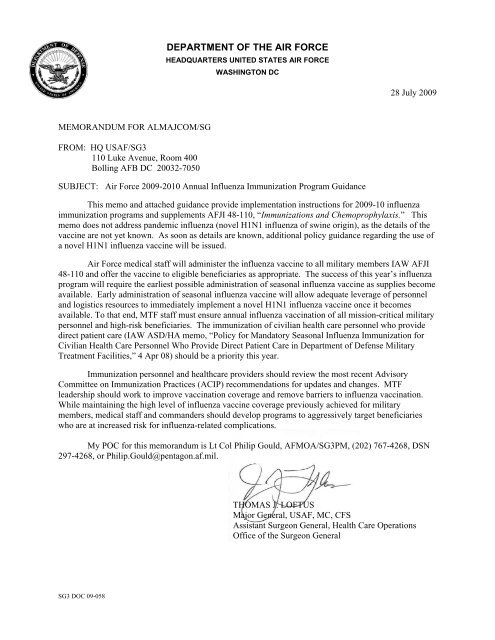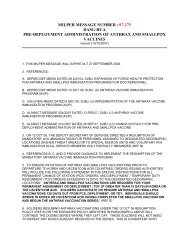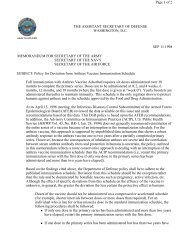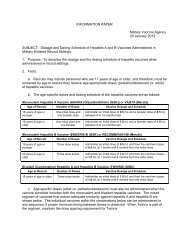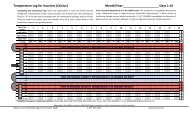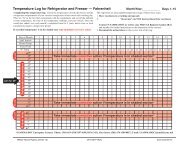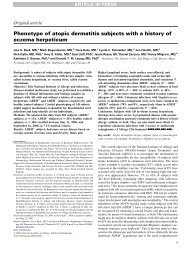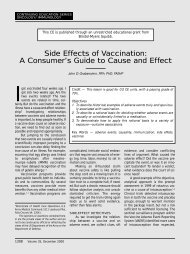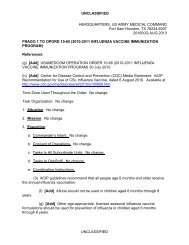DEPARTMENT OF THE AIR FORCE
DEPARTMENT OF THE AIR FORCE
DEPARTMENT OF THE AIR FORCE
You also want an ePaper? Increase the reach of your titles
YUMPU automatically turns print PDFs into web optimized ePapers that Google loves.
<strong>DEPARTMENT</strong> <strong>OF</strong> <strong>THE</strong> <strong>AIR</strong> <strong>FORCE</strong><br />
HEADQUARTERS UNITED STATES <strong>AIR</strong> <strong>FORCE</strong><br />
WASHINGTON DC<br />
28 July 2009<br />
MEMORANDUM FOR ALMAJCOM/SG<br />
FROM: HQ USAF/SG3<br />
110 Luke Avenue, Room 400<br />
Bolling AFB DC 20032-7050<br />
SUBJECT: Air Force 2009-2010 Annual Influenza Immunization Program Guidance<br />
This memo and attached guidance provide implementation instructions for 2009-10 influenza<br />
immunization programs and supplements AFJI 48-110, “Immunizations and Chemoprophylaxis.” This<br />
memo does not address pandemic influenza (novel H1N1 influenza of swine origin), as the details of the<br />
vaccine are not yet known. As soon as details are known, additional policy guidance regarding the use of<br />
a novel H1N1 influenza vaccine will be issued.<br />
Air Force medical staff will administer the influenza vaccine to all military members IAW AFJI<br />
48-110 and offer the vaccine to eligible beneficiaries as appropriate. The success of this year’s influenza<br />
program will require the earliest possible administration of seasonal influenza vaccine as supplies become<br />
available. Early administration of seasonal influenza vaccine will allow adequate leverage of personnel<br />
and logistics resources to immediately implement a novel H1N1 influenza vaccine once it becomes<br />
available. To that end, MTF staff must ensure annual influenza vaccination of all mission-critical military<br />
personnel and high-risk beneficiaries. The immunization of civilian health care personnel who provide<br />
direct patient care (IAW ASD/HA memo, “Policy for Mandatory Seasonal Influenza Immunization for<br />
Civilian Health Care Personnel Who Provide Direct Patient Care in Department of Defense Military<br />
Treatment Facilities,” 4 Apr 08) should be a priority this year.<br />
Immunization personnel and healthcare providers should review the most recent Advisory<br />
Committee on Immunization Practices (ACIP) recommendations for updates and changes. MTF<br />
leadership should work to improve vaccination coverage and remove barriers to influenza vaccination.<br />
While maintaining the high level of influenza vaccine coverage previously achieved for military<br />
members, medical staff and commanders should develop programs to aggressively target beneficiaries<br />
who are at increased risk for influenza-related complications.<br />
My POC for this memorandum is Lt Col Philip Gould, AFMOA/SG3PM, (202) 767-4268, DSN<br />
297-4268, or Philip.Gould@pentagon.af.mil.<br />
THOMAS J. L<strong>OF</strong>TUS<br />
Major General, USAF, MC, CFS<br />
Assistant Surgeon General, Health Care Operations<br />
Office of the Surgeon General<br />
SG3 DOC 09-058
<strong>DEPARTMENT</strong> <strong>OF</strong> <strong>THE</strong> <strong>AIR</strong> <strong>FORCE</strong><br />
HEADQUARTERS UNITED STATES <strong>AIR</strong> <strong>FORCE</strong><br />
WASHINGTON, DC<br />
Air Force 2009-2010 Influenza Immunization Program Guidance<br />
1. Purpose<br />
This message provides Air Force guidance for influenza vaccination programs.<br />
Request dissemination of this message to all military treatment facilities (MTFs),<br />
MTF/CCs, immunization point of service/clinics, public health offices, pharmacy<br />
services, medical logistic/supply sections, and primary care managers.<br />
2. Novel H1N1 Influenza (aka Swine Origin Influenza Vaccine)<br />
This message does not address Novel H1N1 Influenza directly, as additional<br />
vaccine guidance will be forthcoming for this particular agent. The specifics<br />
about vaccination for the Novel H1N1 Influenza are not yet known as of the date<br />
of this guidance (e.g. quantity and number of doses required, presence or absence<br />
of adjuvant, manufacturer(s), and the number of doses that DoD will have<br />
purchased).<br />
3. Influenza<br />
a. Seasonal influenza epidemics occur annually in the United States. Estimates of<br />
influenza-related events include 95 million infections, 25 million physician visits,<br />
200,000 hospitalizations, and 36,000 deaths annually in the United States.<br />
b. Immunization is the key to seasonal influenza prevention.<br />
4. Current Seasonal Influenza Virus Vaccines and Their Availability<br />
a. Do not use leftover vaccines from last year's influenza immunization program<br />
for this year’s program. Many of the preventable vaccine administration<br />
errors came from using outdated vaccine<br />
b. Both the inactivated and live, attenuated vaccines prepared for the 2009-2010<br />
season include an A/Brisbane/59/2007 (H1N1)-like virus, an A/Brisbane/10/2007<br />
(H3N2)-like virus, and a B/Brisbane/60/2008-like virus (changed from the<br />
B/Florida/4/2006-like virus in the 2008-2009 formulation).<br />
c. Influenza viruses for both Trivalent Inactivated Influenza Vaccine (TIV) and Live<br />
Attenuated Influenza Vaccine (LAIV) are grown in embyonated chicken eggs and<br />
might contain limited amounts of residual egg protein. Persons with a history of<br />
severe hypersensitivity to eggs, such as anaphylaxis, should not receive influenza<br />
vaccine.<br />
d. DoD-contracted manufacturers for 2009-2010 are Sanofi Pasteur (SP) and CSL<br />
Biotherapies for the trivalent, inactivated influenza vaccines FluZone ® and
Afluria ® . MedImmune is the contracted manufacturer for the live, attenuated<br />
influenza vaccine, FluMist ® . MedImmune FluMist ® shipments are expected to<br />
begin in August and be 90% complete by the end of October. The shipments of<br />
inactivated vaccines are expected to commence in August and finish by the end of<br />
November.<br />
e. Defense Contracting Supply-Philadelphia (DSCP) obtained 50% of DoD<br />
requirements as FluMist, ® 28% as FluZone ® , and 22% as Afluria ® . FluZone ®<br />
vaccines are the only products currently FDA-approved for infants and children<br />
less than 2 years of age or 2-18 years of age with chronic medical conditions.<br />
FluZone ® should be reserved for these specific pediatric populations, and only<br />
used on adults after pediatric populations have been vaccinated.<br />
f. Due to the various influenza vaccine products available this season it is imperative<br />
that utmost care and attention is devoted to providing correct immunizations based<br />
on age and medical conditions and that recording of immunizations given is<br />
accurate.<br />
g. Air Force Medical Logistics (AFMLO) is responsible for ordering and distributing<br />
influenza vaccine for AFMS activities. AFMLO will notify units of the quantities<br />
ordered and the document numbers being used. Additional quantities required<br />
must be coordinated with AFMOA/SG3SLC, DSN: 343-4170, commercial (301)<br />
619-4170. AFMLO website is: https://medlog.detrick.af.mil/index.cfm<br />
5. Timing of Annual Influenza Immunization<br />
a. Antibodies sufficient to achieve protection against influenza infection usually<br />
develop within two weeks of vaccination and last six to nine months. Influenza<br />
vaccinations should begin as early in the season as is possible. Begin mass<br />
immunization programs as soon as adequate quantities of the vaccine are available.<br />
Influenza activity usually peaks in the United States between late December and<br />
early March. During the past 24 flu seasons, months with the heaviest flu activity<br />
(peak months) occurred in December (4 years - 17%), January (5 years - 21%),<br />
February (10 years - 42%), and March (4 years - 17%). Vaccination of susceptible<br />
individuals into the summer months with un-expired vaccine may be beneficial as<br />
influenza infections occur throughout the year.<br />
b. No prioritization is necessary when production and projected distribution<br />
schedules allow for sufficient supply of influenza vaccine.<br />
c. Vaccination of all military members should be completed within one month of<br />
receipt of sufficient vaccine supplies. Every effort should be made to exceed a<br />
goal of 90% of AD vaccinated by Dec 1, 2009. FluMist ® will be administered to<br />
Service members (including trainees, Guard, and Reserve) 18 through 49 years of<br />
age unless medically contraindicated. Shipments of both types of vaccine are<br />
expected to begin in August with 90% of deliveries accomplished by the end of<br />
November. Current contracts from other manufacturers provide delivery of 60-<br />
70% of DoD requirements by the end of September with the remaining doses to be<br />
delivered by the end of November. National supply and epidemic levels may<br />
restrict vaccine availability.<br />
d. Flying/Special Duty populations: in a study comparing rates of DNIF among rated<br />
AF aircrew who had received either LAIV or TIV, LAIV (FluMist ® ) was found to<br />
2
have equivalent DNIF rates in the week post-immunization as injectable (relative<br />
risk of 0.88 [95% CI 0.73 – 1.06]) (Lowry & Bonnema, personal<br />
communication). Given the results of this study, LAIV should be the preferred<br />
immunization, even among aircrew or special duty populations. Usual procedures<br />
to reduce operational impact (e.g. ½ of personnel receive immunization one week,<br />
½ the next) should remain in place.<br />
e. For other beneficiaries: healthy persons 18 to 49 years of age without medical<br />
contraindications should initially be offered FluMist ® . Vaccination of these<br />
individuals with injectable vaccine should be deferred until the target populations<br />
who require TIV have had ample opportunity to receive the vaccine. FluZone ®<br />
products should be reserved for the appropriate pediatric populations that require<br />
injectable vaccines.<br />
f. Other Prioritization Plans<br />
(1) “It is DoD policy that the recommendations for immunization of the Centers<br />
for disease Control and Prevention and its Advisory Committee for<br />
Immunization Practices shall generally be followed, consistent with<br />
requirements and guidance of the Food and Drug Administration and<br />
consideration for the unique needs of military settings and exposure risks.”<br />
DoDD 6205.02E<br />
(2) In the event of a severe influenza epidemic, extreme vaccine shortage, or<br />
unforeseen distribution delays, target populations will be prioritized in<br />
accordance with Assistant Secretary of Defense, Health Affairs policy<br />
guidance. If necessary, more specific priority alterations will be given at the<br />
direction of AFMOA/SG3PM.<br />
(3) Immunization clinics should make every attempt to comply with state law<br />
related to vaccines preserved with Thimerosal. If Thimerosal-free vaccines are<br />
not available in local communities that require them, do not withhold<br />
immunizations, but obtain consent for immunization. Provide the patient<br />
information regarding the local statute, scientific evidence that vaccines<br />
containing Thimerosal are safe, and the potential risk of not receiving the<br />
vaccine.<br />
g. The CDC’s National Center for Immunization and Respiratory Diseases (NCIRD)<br />
strongly recommends that providers draw vaccine only at the time of<br />
administration to ensure that the cold chain is maintained and that vaccine is not<br />
inappropriately exposed to light. Do not pre-draw doses before they are needed.<br />
h. Although pre-drawing vaccine is generally discouraged, a limited amount of<br />
vaccine may be pre-drawn in a mass immunization setting if the following<br />
procedures are followed:<br />
(1) Only one vaccine type may be administered at the clinic. If more than one<br />
vaccine type is to be administered, separate vaccine administration stations<br />
must be set up for each vaccine type to prevent medication errors.<br />
(2) The type of vaccine, lot number, and date of filling must be carefully labeled<br />
on each syringe, and vaccine should be administered promptly (same day,<br />
preferably within the same hour as drawn), and should be kept within the<br />
manufacturer’s specifications as far as temperature handling before<br />
administration.<br />
3
(3) Vaccine should not be drawn up in advance of arriving at the clinic site.<br />
Because of the lack of data on the stability of vaccine stored in plastic syringes,<br />
the practice of drawing up quantities of vaccine hours or even days before a<br />
clinic is not acceptable.<br />
i. Deployers or travelers who were not vaccinated during the preceding fall or winter<br />
and are deploying/traveling to the Southern Hemisphere during April-September or<br />
to the tropics in organized groups any time of the year should receive influenza<br />
vaccine prior to travel. Caution: The shelf-lives of FDA-approved influenza<br />
vaccines are limited and variable. Follow expiration dates on the package or<br />
bottle. Do not use expired vaccines.<br />
6. Target Groups and Specific Instructions for Influenza Immunization<br />
a. Follow AFJI 48-110 and the most recent ACIP recommendations for specific age<br />
groups and high-risk groups.<br />
b. Influenza vaccination should proceed in parallel for military members, medically<br />
high-risk individuals, and other target populations.<br />
c. Mass immunization campaigns should not be organized until adequate delivery<br />
dates of appropriate vaccine are assured.<br />
d. Pediatric-specific vaccinations should begin as soon as appropriate vaccine is<br />
received; do not await acquisition of adult/Service member supplies to begin<br />
providing pediatric vaccinations.<br />
e. Improve annual influenza vaccination coverage for the following groups<br />
(1) Mandatory: All AD and ARC members in accordance with AFJI 48-110.<br />
(2) Required: All civilian healthcare personnel (HCP) who provide direct patient<br />
care in DoD MTFs as a condition of employment, unless there is a documented<br />
medical or religious reason not to be immunized IAW ASD(HA) Policy Memo<br />
08-005 “Policy for Mandatory Seasonal Influenza Immunization for Civilian Health<br />
Care Personnel Who Provide Direct Patient Care in Department of Defense Military<br />
Treatment Facilities”, 4 Apr 08.<br />
(3) Beneficiaries aged ≥ 65 years. Achieve Healthy People 2010 Target of 90%.<br />
(4) Persons aged 2—64 years with underlying chronic medical conditions.<br />
Achieve Healthy People 2010 Target of 60% for high-risk adults (aged 18-64<br />
years).<br />
(5) Hospitalized patients. Hospitalized patients are often in high risk groups,<br />
including beneficiaries aged ≥ 65 years & aged 2-64 years with underlying<br />
chronic medical conditions.<br />
7. ACIP Recommendations for the Prevention and Control of Influenza<br />
a. Target Groups for Vaccination.<br />
Influenza vaccine should be provided to all persons who want to reduce the risk of<br />
becoming ill with influenza or of transmitting it to others. However, emphasis on<br />
providing routine vaccination annually to certain groups at higher risk for<br />
4
influenza infection or complications is advised, including all children aged 6<br />
months--18 years, all persons aged >50 years, and other adults at risk for medical<br />
complications from influenza or more likely to require medical care should receive<br />
influenza vaccine annually. In addition, all persons who live with or care for<br />
persons at high risk for influenza-related complications, including contacts of<br />
children aged
(3) Persons Who Live With or Care for Persons at High Risk for Influenza-<br />
Related Complications<br />
To prevent transmission to persons identified above, vaccination with TIV or<br />
LAIV (unless contraindicated) also is recommended for the following persons.<br />
When vaccine supply is limited, vaccination efforts should focus on delivering<br />
vaccination to these persons:<br />
(a) HCP;<br />
(b) healthy household contacts (including children) and caregivers of children<br />
aged
inserts contradict ACIP recommendations. Therefore, immunization clinics must<br />
coordinate vaccination of pregnant women with their caregivers.)<br />
c. Rationale for Immunization of Specific Groups<br />
(1) Persons Infected with HIV. Influenza can result in serious illness. As<br />
vaccination with inactivated influenza vaccine can result in the production<br />
of protective antibody titers, vaccination will benefit HIV-infected persons,<br />
including HIV-infected pregnant women. FluMist ® is contraindicated,<br />
however, in persons with severely reduced immune competency.<br />
(2) Persons Who Can Transmit Influenza to Those at High Risk<br />
(a) Health-care workers<br />
(b) Employees of assisted living and other residences for persons in groups at<br />
high risk<br />
(c) Persons who provide home care to persons in groups at high risk<br />
(d) Household contacts (including children) of persons in groups at high risk.<br />
(e) Household contacts (anyone who spends a significant amount of time in<br />
the home) and out-of-home caregivers of children 0-59 months old.<br />
(f) Healthy persons aged 2-49 years who are close contacts of severely<br />
immune-suppressed persons should receive inactivated influenza vaccine<br />
rather than the attenuated, live vaccine (FluMist ® ).<br />
(3) Persons Aged 50-64 Years. Vaccination is recommended for all appropriate<br />
persons aged 50--64 years. This group has an increased prevalence of<br />
undiagnosed high-risk conditions.<br />
(4) Healthy Young Children<br />
(5) Children aged 6-59 months. This group has a substantially increased risk for<br />
influenza-related hospitalizations<br />
(6) ACIP has expanded the age through 18 years to reduce the spread of<br />
influenza within the community. The Vaccines for Children (VFC) program<br />
was expanded to include additional influenza vaccine coverage as of 1 July<br />
2008.<br />
(7) General Population<br />
(a) Administer influenza vaccine to any person who wishes to reduce the<br />
likelihood of becoming ill with influenza or transmitting influenza to<br />
others should they become infected<br />
(b) Vaccinate persons who provide essential community services to minimize<br />
disruption of essential activities during influenza outbreaks.<br />
(c) Encourage students or other persons in institutional settings (e.g., those<br />
who reside in dormitories) to receive vaccine to minimize the disruption<br />
of routine activities during epidemics.<br />
(d) Live, attenuated FluMist ® should be used whenever not otherwise<br />
contraindicated in the healthy, non-pregnant 2-49 year old populations<br />
8. Implementation Strategies to Improve Vaccination Rates.<br />
a. Utilize reminder and recall systems to target beneficiaries at increased risk for<br />
complications from influenza.<br />
7
(1) Primary care managers should facilitate identification of target patients for<br />
reminder recall.<br />
(2) The Population Health Support Division (PHSD) provides MTFs’ patientenrollment<br />
data through the AF Population Health Portal (AFPHP). MTFs<br />
can contact PHSD at DSN 240-8190, comm. (210) 536-8190 email:<br />
phsohelpdesk@brooks.af.mil for information about accessing the AFPHP.<br />
b. Implement standing orders or standard operating procedures. Examples include<br />
pre-written vaccine orders for adults or other high-risk beneficiaries; provide<br />
hospitalized patients flu vaccine prior to discharge; remind pregnant women to<br />
receive vaccine during routine prenatal care.<br />
c. Assess vaccination coverage rates. MTFs should regularly assess their vaccine<br />
coverage rates throughout the influenza season and attempt to improve coverage<br />
for military members, enrolled infants and children 6 months to 18 years of age,<br />
enrolled beneficiaries aged ≥ 50 years and other medically high-risk individuals.<br />
Information on vaccine completion rates for certain groups is updated regularly<br />
and available at the Air Force Corporate Health Information Processing Service<br />
(AFCHIPS) website.<br />
d. Use self-identification questionnaires and clinic posters. Post informational<br />
materials in patient care areas, waiting rooms, prenatal and immunization clinics,<br />
and other areas likely to target high-risk groups. Appropriate materials are<br />
available at: http://www.cdc.gov/flu/<br />
e. Employ other patient-oriented and community-based approaches to reach target<br />
populations<br />
f. Use the opportunity to evaluate service member and beneficiary shot records to<br />
update other immunizations wherever possible<br />
g. Persons with certain underlying medical conditions will also benefit from<br />
pneumococcal vaccination if not previously vaccinated. MTFs should identify<br />
eligible individuals and use opportunity during influenza campaign to ensure that<br />
these individuals are up-to-date on pneumococcal vaccination in accordance with<br />
ACIP recommendations or<br />
http://www.cdc.gov/mmwr/preview/mmwrhtml/00047135.htm. The Healthy<br />
People 2010 target for one-time pneumococcal vaccination for adults aged ≥ 65<br />
years is 90%.<br />
h. Influenza vaccination for federal civilian employees, foreign nationals or other<br />
non-DoD individuals. See AFJI 48-110 for guidance.<br />
i. MTFs should ensure communication of plan and local strategies to all involved<br />
parties. Public affairs resources are available through CDC at<br />
http://www.cdc.gov/flu.<br />
9. Documentation:<br />
a. All vaccinations will be documented in Air Force Complete Immunization<br />
Tracking Application (AFCITA). Mass immunization and workplace vaccination<br />
campaign planning must consider this requirement for AD, Reserve Component,<br />
and DoD beneficiaries (e.g., automated methods on-site or manual lists at<br />
vaccination site compiled and used to update AFCITA). The AFCHIPS website<br />
provides base-level influenza vaccination completion data throughout influenza<br />
season and is available at https://www.afchips.brooks.af.mil/main.htm.<br />
8
. Accurate documentation of Flu vaccines given during Flu vaccine programs<br />
continues to be a challenge. All influenza immunizations administered will be<br />
entered into AFCITA. MTFs are strongly encouraged to utilize the stand-alone<br />
capacity of AFCITA when giving immunizations outside the MTF. Paper “sign-in<br />
rosters” are discouraged. If paper rosters must be utilized, data must be entered<br />
into AFCITA within 24 hours.<br />
10. DoD Contracted Vaccines<br />
a. Live, attenuated influenza vaccine (LAIV)— FluMist ®<br />
(1) Description of FluMist ®<br />
(a) FluMist ® is intended for intranasal use only. Do not administer<br />
vaccine as an injection.<br />
(b) FluMist ® should be administered by a healthcare practitioner.<br />
FluMist ® should not be self-administered by the individual.Coldadapted,<br />
temperature-sensitive, live trivalent vaccine.<br />
(c) Designed to stimulate an immune response that more closely resembles<br />
the body’s response to a natural influenza infection.<br />
(d) Stimulates local defenses in the nasal mucosa against influenza and<br />
promotes a systemic immune response.<br />
(e) Contains attenuated live vaccine strains that are engineered not to cause<br />
systemic disease<br />
1 Attenuated: weakened so as not to cause influenza-like illness<br />
2 Cold-adapted: replicates efficiently in the cooler temperatures of the<br />
nasopharynx<br />
3 Temperature-sensitive: does not replicate efficiently in the warmer<br />
temperatures of the lower respiratory tract<br />
(2) Indication<br />
(a) FluMist ® is indicated for active immunization for the prevention of<br />
disease caused by influenza A and B viruses in non-pregnant, healthy<br />
persons aged 2-49 years.<br />
(b) Children 2-8 years old receiving vaccination with any influenza vaccine<br />
for the first time need two doses. Those who received only 1 dose in<br />
their first year of vaccination should receive 2 doses in the following<br />
year. FluMist ® doses should be separated by ≥6 weeks.<br />
(c) Persons 9-49 years old need only one initial dose.<br />
(3) Contraindications for use of FluMist ®<br />
(a) FluMist ® must not be administered parenterally.<br />
(b) Allergic history. Individuals with a history of hypersensitivity, especially<br />
anaphylactic reactions, to any component of FluMist ® including eggs or<br />
egg products, should not receive FluMist ® .<br />
(c) Aspirin therapy. FluMist ® is contraindicated in children and adolescents<br />
receiving aspirin therapy or aspirin-containing therapy because of the<br />
9
association of Reye’s syndrome with aspirin and wild-type influenza<br />
infection.<br />
(d) Guillain-Barré Syndrome. FluMist ® should not be administered to<br />
individuals who have a history of Guillain-Barré syndrome.<br />
(e) Immune deficiency. FluMist ® should not be administered to individuals<br />
with known or suspected immune deficiency diseases such as combined<br />
immunodeficiency, agammaglobulinemia, thymic abnormalities, human<br />
immunodeficiency virus infection, leukemia, lymphoma, or other<br />
malignant conditions. FluMist ® is also contraindicated in patients who<br />
may be immunosuppressed or have altered or compromised immune<br />
status as a consequence of treatment with systemic corticosteroids,<br />
alkylating drugs, antimetabolites, radiation, or other immunosuppressive<br />
therapies.<br />
(f) Respiratory disease. Warning. The safety of FluMist ® in individuals<br />
with asthma or reactive airways disease has not been established.<br />
Therefore, FluMist ® should not be administered to individuals with a<br />
history of asthma or reactive airway disease. Clinicians and immunization<br />
program staff should screen for possible reactive airway disease when<br />
considering use of LAIV for children aged 2 through 4 years, and should<br />
avoid use of this vaccine in children with asthma or a recent wheezing<br />
episode<br />
(g) Pregnancy and breastfeeding. FluMist ® is not licensed for use in<br />
pregnant women. Breastfeeding women may be given either TIV or<br />
LAIV (FluMist ® ) unless contraindicated by another medical condition.<br />
(h) Other medical conditions. The safety of FluMist ® in individuals with<br />
underlying medical conditions that may predispose them to severe<br />
disease following wild-type influenza infection has not been established.<br />
FluMist ® is not indicated for these individuals. High-risk individuals<br />
include, but are not limited to, adults and children with chronic disorders<br />
of the cardiovascular and pulmonary systems, including asthma; pregnant<br />
women; adults and children who required regular medical follow-up or<br />
hospitalization during the preceding year because of chronic metabolic<br />
diseases (including diabetes), renal dysfunction, or hemoglobinopathies;<br />
and adults and children with congenital or acquired immunosuppression<br />
caused by underlying disease or immunosuppressive therapy.<br />
(i) FluMist ® is indicated for the active immunization of healthy children and<br />
adolescents 2-17 years of age, and healthy adults, 18-49 years of age,<br />
against influenza disease caused by influenza types A and B contained in<br />
the vaccine. FluMist® is not indicated for immunization of individuals<br />
less than 2 years of age, or 50 years of age and older, or for therapy of<br />
influenza, nor will it protect against infections and illnesses caused by<br />
infectious agents other than influenza A or B viruses.<br />
(4) Precautions<br />
(a) Prior to administration of FluMist ® , individuals or their parent/guardian<br />
should be asked about their current health status and their personal<br />
10
medical history, including immune status, to determine the existence of<br />
any contraindications to immunization with FluMist ® .<br />
(b) FluMist ® recipients should avoid close contact (e.g., within the same<br />
household) with immunocompromised individuals for at least 21 days.<br />
(c) Epinephrine injection or comparable treatment must be readily available<br />
in the event of an acute anaphylactic reaction following vaccination.<br />
(d) Administration of FluMist ® should be postponed until after the acute<br />
phase (at least 72 hours) of febrile and/or respiratory illnesses.<br />
(e) Based on the potential for interference between antiviral compounds and<br />
FluMist ® , it is advisable not to administer FluMist ® until 48 hours after<br />
the cessation of antiviral therapy and that antiviral agents not be<br />
administered until two weeks after administration of FluMist ® unless<br />
medically indicated.<br />
(f) Concurrent administration with other vaccines. The safety and<br />
immunogenicity of FluMist ® when administered concurrently with other<br />
vaccines has not been determined. Healthcare providers should consider<br />
the risks and benefits of concurrent administration of FluMist ® with<br />
other vaccines.<br />
(g) There is no data available regarding co-administration of FluMist ® with<br />
other intranasal preparations, including steroids.<br />
(h) Aeromedical disposition policy following administration of this vaccine<br />
is the same as for injectable immunizations as outlined in the Aircrew<br />
Medication List policy letter dated 22 Sep 04. Symptoms such as runny<br />
nose, congestion, mild headache, sore throat, and fatigue or weakness<br />
may occur within the first 7 days. The presence and severity of these<br />
symptoms may require Duty Not Including Flying/Duty Not Including<br />
Controlling (DNIF/DNIC) action for some aircrew and special<br />
operational duty personnel. To minimize operational impact, it is<br />
recommended that no more than 50% of those eligible in each unit be<br />
administered the vaccine within any given week. The Chief of Aerospace<br />
Medicine for each base should work closely with flying and special<br />
operational duty commanders to devise a FluMist® immunization plan<br />
for these personnel.<br />
(5) Adverse Events<br />
(a) In children, side effects can include runny nose, headache, vomiting,<br />
muscle aches, and fever.<br />
(b) In adults, side effects can include runny nose, headache, sore throat, and<br />
cough. Fever is not a common side effect in adults.<br />
(c) Other adverse events reported include nausea, rash, and hypersensitivity<br />
reactions (including anaphylaxis, facial edema, and urticaria).<br />
(6) Conditions of transportation, arrival, and storage<br />
(a) FluMist® should arrive frozen.<br />
(b) The cold chain must be maintained when transporting FluMist ® .<br />
(c) FluMist® should be stored in a refrigerator between 2-8° C (35-46° F)<br />
upon receipt and until use before the expiration date.<br />
11
(d) DO NOT REFREEZE.<br />
(e) For information regarding product storage and stability under conditions<br />
other than those recommended, call 1-877-FLUMIST. Recipients of<br />
overseas shipments should consult DSCP for questions related to<br />
enclosed “Temp Tale” monitors.<br />
(7) Administration<br />
(a) FluMist ® is intended for intranasal use only. Do not administer<br />
vaccine as an injection.<br />
(b) FluMist ® should be administered by a healthcare practitioner.<br />
FluMist ® should not be self-administered by the individual.<br />
(c) Approximately 0.1 mL (i.e., half of the dose from a single FluMist ®<br />
sprayer) is administered into each nostril while the recipient is in an<br />
upright position. Insert the tip of the sprayer just inside the nose and<br />
rapidly depress the plunger until the dose-divider clip stops the plunger.<br />
The dose-divider clip is removed from the sprayer to administer the<br />
second half of the dose (approximately 0.1ml) into the other nostril. The<br />
product should be extruded as a mist, not droplets!<br />
(d) Once FluMist ® has been administered, the sprayer should be disposed in<br />
accordance with standard procedures for medical waste.<br />
b. Trivalent Inactivated Influenza Vaccines (TIV)<br />
(1) Inactivated influenza vaccines are FDA-approved for specific age groups.<br />
Follow package insert for use of influenza vaccines in the appropriate age<br />
groups. Five injectable influenza vaccine formulations are available for the<br />
2009–2010 season.<br />
(a) Afluria® —Influenza virus vaccine, USP Split Trivalent 0.5 ml singledose<br />
prefilled syringes for immunizing persons 18 years of age and<br />
older.<br />
(b) FluZone ® —Influenza virus vaccine, USP Split Trivalent 0.25 and 0.5 ml<br />
single dose syringes and multi-dose 5 ml vials for immunizing persons 6<br />
months of age and older. RESERVE <strong>THE</strong> PEDIATRIC SPECIFIC<br />
PRODUCTS FOR USE IN <strong>THE</strong>SE PATIENTS until their needs are<br />
adequately served.<br />
(2) Afluria ® —Trivalent Inactivated Influenza Vaccine (TIV)<br />
(a) Indication<br />
1 Afluria ® is an inactivated influenza vaccine indicated for active<br />
immunization of persons 18 years of age and older against influenza<br />
disease caused by influenza virus subtypes A and type B present in<br />
the vaccine.<br />
2 This indication is based on the immune response elicited by Afluria®;<br />
there have been no controlled clinical studies demonstrating a<br />
decrease in influenza disease after vaccination with Afluria ® .<br />
12
(b) Vaccine arrival, storage, and transportation<br />
1 Afluria ® should not be frozen during transportation. If the enclosed<br />
temperature monitor’s indicator light is red, do not issue to users until<br />
serviceability is confirmed by the “Temp Tale” monitor at the<br />
Defense Supply Center Philadelphia (DSCP). Follow indicator<br />
instructions enclosed with each shipment.<br />
2 Refrigerate Afluria ® immediately on arrival and store at 2-8 o<br />
Centigrade (36-46 o F). Do not freeze. Any vaccine that has been<br />
frozen or is suspected of being frozen should not be administered.<br />
Contact DSCP for instructions prior to destroying and vaccine.<br />
Protect from light. Store in the original package to protect from light.<br />
3 Do not put Afluria ® vaccine directly on ice during local transport.<br />
Place cold packs in a suitable cooler and let the temperature stabilize<br />
for 5-10 minutes. (The recommendation is that 2-8 o C is best for<br />
transporting vaccine). Place vaccine in the container only after the<br />
temperature is stable. Check the temperature with a thermometer.<br />
(c) Vaccine instructions<br />
1 Draw and administer vaccine IAW the Advisory Committee on<br />
Immunization Practices (ACIP) guidelines.<br />
2 Afluria ® should be inspected visually for particulate matter and<br />
discoloration prior to administration. If either of these conditions<br />
exists, the vaccine should not be administered.<br />
3 When using the preservative-free, single-dose syringe, shake the<br />
syringe thoroughly and administer the dose immediately.<br />
4 If you have multi-dose vials for use, shake the vial thoroughly before<br />
withdrawing each dose and administer the dose immediately.<br />
Between uses, store the vial at 2-8 o Centigrade (36-46 o F). Once the<br />
stopper has been pierced, the vial must be discarded within 28<br />
days.<br />
5 Afluria ® should be administered as a single 0.5 mL intramuscular<br />
injection, preferably in the deltoid muscle of the upper arm.<br />
6 Do not inject intravenously. Avoid injection in areas where there<br />
may be a major nerve trunk.<br />
7 Shelf life: The vaccine is good until the expiration date listed on<br />
vaccine or package insert as long as it is properly stored, has not<br />
been contaminated, or the stopper pierced. Do not use Afluria ®<br />
beyond the expiration date printed on the label or 28 days once the<br />
vial has been pierced.<br />
(d) Inactivated influenza vaccines are FDA-approved for specific age groups.<br />
Follow package insert for use of influenza vaccines in the appropriate age<br />
groups. The injectable influenza vaccines available for the 2009-2010<br />
season are:<br />
1 Afluria ® —Influenza Virus Vaccine, USP, 0.50 Ml dose, 10 dose<br />
vial; for immunizing persons 18 yrs and older<br />
13
2 Afluria ® — Influenza Virus Vaccine, USP, 0.50 Ml dose, pre-filled<br />
needle syringe unit, 10 count, for immunizing person 18 years of age<br />
and older.<br />
(e) Precautions<br />
1 Prior to administration of Afluria ® , the patient’s current health status<br />
and medical history should be reviewed.<br />
2 Inform the patient that Afluria ® is an inactivated vaccine that cannot<br />
cause influenza but stimulates the immune system to produce<br />
antibodies that protect against influenza. The full effect of the<br />
vaccine is generally achieved approximately 3 weeks after<br />
vaccination. Annual revaccination is recommended.<br />
3 Instruct the patient to report any severe or unusual adverse reactions<br />
to their healthcare provider.<br />
4 Do not administer by intravascular injection.<br />
5 Appropriate medical treatment and supervision must be available to<br />
manage possible anaphylactic reactions following administration of<br />
the vaccine. Serious allergic reactions, including anaphylactic shock,<br />
have been observed during post marketing surveillance in individuals<br />
receiving Afluria ® .<br />
(f) Contraindications<br />
1 Afluria ® is contraindicated in individuals with known hypersensitivity<br />
to eggs or chicken protein, neomycin, or polymyxin, or in anyone<br />
who has had a life-threatening reaction to previous influenza vaccine.<br />
2 If Guillain-Barré Syndrome has occurred within 6 weeks of previous<br />
influenza vaccine, the decision to give Afluria ® should be based on<br />
careful consideration of the potential benefits and risks.<br />
3 Vaccination with Afluria ® may not protect all individuals. If Afluria ®<br />
is administered to immunocompromised persons, including those<br />
receiving immunosuppressive therapy, the immune response may be<br />
diminished.<br />
4 Pregnancy. Category C: Animal reproduction studies have not been<br />
conducted with Afluria ® . It is not known whether Afluria ® can cause<br />
fetal harm when administered to a pregnant woman or can affect<br />
reproduction capacity. Afluria ® should be given to a pregnant woman<br />
only if clearly needed. The ACIP has issued recommendations<br />
regarding the use of the influenza virus vaccine in pregnant women.<br />
5 Nursing Mothers. Afluria ® has not been evaluated in nursing<br />
mothers. It is not known whether Afluria ® is excreted in human milk.<br />
Because many drugs are excreted in human milk, caution should be<br />
exercised when Afluria® is administered to a nursing woman. The<br />
ACIP has issued recommendations regarding the use of the influenza<br />
vaccine in nursing mothers.<br />
6 Pediatric Use. Safety and effectiveness in the pediatric population<br />
have not been established.<br />
7 Geriatric Use. Hemaglutination-inhibiting antibody responses in<br />
geriatric subjects were lower after administration of Afluria ® in<br />
14
comparison to younger adult subjects. Adverse event rates were<br />
generally similar in frequency to those reported in subjects ages 18 to<br />
less than 65 years, although some differences were observed.<br />
8 The ACIP has published guidelines for vaccination of persons with<br />
recent or acute illness (www.cdc.gov).<br />
9 Immunization should be delayed in a patient with an active<br />
neurological disorder, but should be considered when the disease<br />
process has been stabilized.<br />
(3) FluZone ® —Trivalent Inactivated Influenza Vaccine (TIV).<br />
(a) Indication. Trivalent inactivated influenza vaccine is approved for<br />
persons aged >6 months including those with high-risk conditions.<br />
(b) Vaccine arrival, storage, and transportation<br />
1 FluZone ® vaccine should not be frozen during transportation. If the<br />
enclosed temperature monitor’s indicator light is red, do not issue to<br />
users until serviceability is confirmed by the “Temp Tale” monitor at<br />
the Defense Supply Center Philadelphia (DSCP). Follow indicator<br />
instructions enclosed with each shipment.<br />
2 Refrigerate vaccine immediately on arrival and store at 2-8 o<br />
Centigrade (35-45 o Fahrenheit). Do not freeze.<br />
3 Do not put vaccine directly on ice during local transport. Place cold<br />
packs in a suitable cooler and let the temperature stabilize for 5-10<br />
minutes. Check the temperature with a thermometer. (The<br />
manufacturer’s recommendation for transporting vaccine is 2-8 o C.)<br />
Place vaccine in the container only after the temperature is stable.<br />
(c) Vaccine instructions<br />
1 Draw and administer vaccine IAW the Advisory Committee on<br />
Immunization Practices (ACIP) guidelines.<br />
2 Shake vials vigorously before withdrawing each dose. Shake<br />
prefilled syringes well before administering.<br />
3 Shelf life: The vaccine is good until the expiration date listed on<br />
vaccine vial or package insert as long as it is properly stored and not<br />
contaminated.<br />
(d) Inactivated influenza vaccines are FDA-approved for specific age groups.<br />
Follow package insert for use of influenza vaccines in the appropriate age<br />
groups. The injectable influenza vaccines available for the 2009–2010<br />
season are:<br />
1 FluZone ® —Influenza virus vaccine, USP Trivalent, contains<br />
preservative, 5.0 ml multi-dose vial; for immunizing persons 6 to 35<br />
months of age (0.25 ml) and 36 months and older (0.5 ml); between<br />
10 and 20 doses.<br />
2 FluZone ® —Influenza virus vaccine, USP Trivalent Syringe-Needle<br />
Unit 10 Split Virus, Thimerosal/Preservative-free: 0.25 ml dose, for<br />
immunizing persons 6-35 months of age.<br />
15
3 FluZone ® —Influenza virus vaccine, USP Trivalent Syringe-Needle<br />
Unit 10 Split Virus, Thimerosal/Preservative-free: 0.5 ml dose, for<br />
immunizing persons older than 35 months of age.<br />
(e) Precautions<br />
1 Administer with caution to subjects with thrombocytopenia or a<br />
bleeding disorder since bleeding may occur following an<br />
intramuscular administration to these subjects.<br />
2 Use of influenza virus vaccine should be delayed during the course of<br />
any febrile respiratory illness or other active infection.<br />
3 The stopper to the vial of influenza vaccine contains dry natural latex<br />
rubber that may cause allergic reactions. The syringe does not<br />
contain latex of any kind.<br />
(f) Contraindications<br />
1 Allergic history. Influenza vaccine should not be administered to<br />
persons with known anaphylactic hypersensitivity to eggs or to other<br />
components of the influenza vaccine without first consulting a<br />
physician (information on vaccine components can be found in<br />
package inserts). Persons who have had hives or swelling of the lips<br />
or tongue, or who have experienced acute respiratory distress or<br />
collapse after eating eggs should consult a physician for appropriate<br />
evaluation to help determine if vaccine should be administered. Mild<br />
systemic reaction with fever, malaise, myalgia, and local redness at<br />
the injection site should not be considered to be an allergic reaction to<br />
influenza vaccine. These side effects are self-limiting and resolve<br />
quickly. Persons who have a history of anaphylactic hypersensitivity<br />
to vaccine components but who are also at high risk for complications<br />
from influenza may benefit from vaccine after appropriate allergy<br />
evaluation and, if necessary, desensitization. Protocols have been<br />
published for safely administering influenza vaccine to persons with<br />
egg allergies.<br />
2 Current infections. Persons with moderate to severe acute infectious<br />
illnesses normally should not be vaccinated until their symptoms have<br />
improved. However, minor illnesses with or without fever,<br />
particularly among children with minor upper respiratory tract<br />
infection or allergic rhinitis; do not contraindicate the use of influenza<br />
vaccine.<br />
3 Pregnancy or Breastfeeding. Neither pregnancy nor breastfeeding is a<br />
contraindication to inactivated influenza immunization.<br />
4 Neurological disease and history of Guillain-Barré Syndrome (GBS).<br />
Whether influenza vaccination increases the risk for recurrence of<br />
GBS is unknown. Avoid vaccinating individuals known to have<br />
experienced GBS within 6 weeks after a previous influenza<br />
vaccination who are not at high risk for severe influenza<br />
complications. Physicians might consider using influenza antiviral<br />
chemoprophylaxis for these persons. For the majority of persons who<br />
have a history of GBS and are at high risk for severe complications<br />
16
from influenza the established benefits of influenza vaccination<br />
justify yearly vaccination. Immunization should be delayed in a<br />
patient with an active neurological disorder but should be<br />
reconsidered when the disease process has been stabilized.<br />
(g) Side effects and adverse reactions<br />
1 When educating patients regarding potential side effects it should be<br />
emphasized that inactivated influenza vaccine contains noninfectious,<br />
killed viruses which cannot cause influenza and that coincidental<br />
respiratory diseases unrelated to influenza vaccination can occur after<br />
vaccination.<br />
2 Side effects and adverse reactions: When educating patients<br />
regarding potential side effects it should be emphasized that<br />
inactivated influenza vaccine contains noninfectious, killed viruses<br />
which cannot cause influenza and that coincidental respiratory<br />
diseases unrelated to influenza vaccination can occur after<br />
vaccination. Most events are mild and self-limited.<br />
a Local reactions (affecting 10-64% of patients) include pain,<br />
redness, and swelling at the vaccination site and can last up to 2<br />
days. These local reactions typically are mild and rarely interfere<br />
with the person’s ability to conduct usual daily activities.<br />
b Systemic reactions including fever, malaise, myalgia, fatigue,<br />
headache, shivering, and other systemic symptoms may begin 6-<br />
12 hours after vaccination and can persist for 1-2 days. These<br />
symptoms most often affect persons who have had no prior<br />
exposure to the influenza virus antigens in the vaccine, e.g.,<br />
young children.<br />
c Immediate, presumably allergic, reactions (e.g., hives,<br />
angioedema, allergic asthma, and systemic anaphylaxis) occur<br />
rarely after influenza vaccination. These reactions probably result<br />
from hypersensitivity to certain vaccine components. The<br />
majority of reactions probably are caused by residual egg protein<br />
from the manufacturing process.<br />
11. Vaccine Information Statement (VIS) and Vaccine Adverse Event Reporting<br />
System (VAERS)<br />
a. VIS and Patient Information. The VIS on influenza vaccine, published by the<br />
CDC, should be made available and provided to any individual upon request. The<br />
VIS is available at http://www.cdc.gov/vaccines/pubs/vis/default.htm.<br />
b. VAERS Reporting. Health-care professionals should promptly report all<br />
clinically significant adverse events after influenza vaccination of children to<br />
VAERS, even if the health-care professional is not certain that the vaccine caused<br />
the event. All vaccine-related adverse events must be reported through the<br />
Vaccine Adverse Event Reporting System. The Institute of Medicine has<br />
specifically recommended reporting of potential neurological complications (e.g.,<br />
demyelinating disorders such as Guillain-Barré Syndrome), although no evidence<br />
exists of a causal relationship between influenza vaccine and neurological<br />
17
disorders in children. The VAERS form is available at http://vaers.hhs.gov. The<br />
form must be submitted to the Food and Drug Administration (FDA) and it may be<br />
transmitted electronically.<br />
c. AF and DoD Reporting. Vaccine adverse events are DoD reportable events and<br />
must also be submitted to the US Air Force School of Aerospace Medicine<br />
(USAFSAM), Epidemiology Consult Service by fax at DSN 240-6841 or (210)<br />
536-6841. VAERS reporting will be integrated into AFRESS once the web-based<br />
version is complete.<br />
d. Life threatening adverse events. Incidents that are considered life-threatening or<br />
that result in death must be reported to USAFSAM within 24 hours. Phone<br />
numbers DSN 240-5497 / 3471; Comm (210) 536-5497 / 3471. Other reports of<br />
vaccine adverse reactions or events should be faxed or mailed within 7 days of<br />
occurrence.<br />
12. ANG and AFRES Activities<br />
a. Air National Guard (ANG) Activities: For the 2009-2010 influenza season, ANG<br />
units should requisition influenza vaccine thru their Active Duty hosts. ANG Wing<br />
requirements are based on data in AFCITA. Each ANG Wing's and its GSUs vaccine<br />
requisition will have a unique document number linked to the local ANG MDG FY<br />
DODAAC. Delivery will be made to the ANG MDG. Flu vaccine funds for FY09<br />
have been distributed to the Wing FMs via checkbook. Proof of receipt should<br />
include: document number, stock number, and quantity, as well as a copy of any<br />
shipping paperwork or Bill of Lading. This is necessary for your host to close the<br />
requisition and complete EOY financial reconciliation. This is a mandatory part of the<br />
process. Questions should be directed to MSgt Piers Heriz-Smith, DSN 278-8577,<br />
Piers.Heriz-Smith@ang.af.mil.<br />
a. Air Force Reserve Command (AFRC) Activities: AFRC activities should contact<br />
the host base (FM) account for their requirements. Contact HQ AFRC/SGPH at<br />
DSN 497-2398 or commercial at 478-327-2398 if further instruction is necessary.<br />
Individual Mobilization Augmentees will be immunized by their supporting AD<br />
MTF and should be included in requirements for the MTF.<br />
13. Contact information<br />
a. Influenza vaccine supply, delivery, shortage and availability issues: Contact<br />
AFMSA/SGSLC, Fort Detrick, MD. DSN 343-4170 or (301) 619-4170, fax: DSN<br />
343-6844 or (301) 619-6844, e-mail: sgslc@ft-detrick.af.mil<br />
b. Policy and prioritization: Contact Philip Gould, Lt Col, AFMSA/SG3PM, 110<br />
Luke Ave, Room 405, Bolling AFB, DC 20032-7050, DSN 297-5424 or (202)<br />
767-5424, e-mail: philip.gould@pentagon.af.mil.<br />
c. VAERS: Contact USAFSAM Epidemiology Services at 2513 Kennedy Circle,<br />
Brooks City Base, Texas 78235-5116 at DSN 240-3471 or (210) 536-3471, fax<br />
DSN 240-6841. https://gumbo.brooks.af.mil/pestilence/VAERS/VAERS.cfm. E-<br />
mail: vaers@brooks.af.mil<br />
18
14. References<br />
a. AFJI 48-110 Immunizations and Chemoprophylaxis, 29 Sep 2006<br />
b. HQ USAF/A1S policy dtd 22 Apr 08 “2008 Recommended Immunization<br />
Schedules”<br />
c. Assistant Secretary of Defense, Health Affairs policy documents available at:<br />
http://www.ha.osd.mil/policies/default.cfm<br />
d. Centers for Disease Control and Prevention (CDC) influenza home page contains<br />
provider’s information, supply concerns and updates, public affairs and media<br />
materials, and patient education materials.<br />
http://www.cdc.gov/flu/professionals/patiented.htm.<br />
e. Prevention and Control of Influenza, Recommendations of the Advisory<br />
Committee on Immunization Practices (ACIP). MMWR 58 (Early Release), 24<br />
July 2009; pp 1-52, available at<br />
http://www.cdc.gov/mmwr/preview/mmwrhtml/rr58e0724a1.htm<br />
f. Morbidity and Mortality Weekly Report, Prevention of Pneumococcal Disease:<br />
Recommendations of the Advisory Committee on Immunization Practices.<br />
Volume 46, Number RR-8, 4 April 1997.<br />
http://www.cdc.gov/mmwr/preview/mmwrhtml/00047135.htm.<br />
g. Morbidity and Mortality Weekly Report, Use of Standing Orders Programs to<br />
Increase Adult Vaccination Rates. Volume 49, RR-01, 24 March 00.<br />
http://www.cdc.gov/mmwr/preview/mmwrhtml/rr4901a2.htm.<br />
h. Morbidity and Mortality Weekly Report, Notice to Readers, Facilitating Influenza<br />
and Pneumococcal Vaccination through Standing Orders Programs. Volume 52,<br />
Number 4, 31 January 2003, pp.68-69.<br />
http://www.cdc.gov/mmwr/PDF/wk/mm5204.pdf<br />
i. Healthy People 2010. U.S. Department of Health and Human Services, 2000.<br />
www.health.gov/healthypeople/document/tableofcontents.htm.<br />
j. Standards for Adult Immunization Practices. Poland, GA et al. American Journal<br />
of Preventive Medicine 2003; Vol 25, Number 2.<br />
k. Recommended Childhood (0-6 years) Schedule: United States, 2009.<br />
http://www.cdc.gov/vaccines/recs/schedules/downloads/child/2009/09_0-<br />
6yrs_schedule_pr.pdf<br />
l. Adolescent Immunization Schedule: United States, 2009.<br />
http://www.cdc.gov/vaccines/recs/schedules/downloads/child/2009/09_7-<br />
18yrs_schedule_pr.pdf<br />
m. DoD Worldwide Influenza Surveillance Program (USAFSAM) .<br />
http://www.geis.fhp.osd.mil/GEIS/SurveillanceActivities/Influenza/influenza.asp<br />
n. DoDD 6205.02E, 19 Sep 2006. Policy and Program for Immunizations to Protect<br />
the Health of Service Members and Military Beneficiaries.<br />
http://www.vaccines.mil/documents/973Policy620502p.pdf<br />
o. National Influenza Vaccine Summit Newsletter. http://www.amaassn.org/ama/pub/physician-resources/public-health/vaccination-resources/adultvaccination/national-influenza-vaccine.shtml<br />
p. ASD (HA) Policy 08-005 http://www.health.mil/HAPolicies.aspx<br />
19
Annex 1<br />
Contents of Influenza Program Guidance<br />
Purpose 1<br />
Current Seasonal Influenza Virus Vaccines and Their Availability 1<br />
Timing of Annual Influenza Immunization 2<br />
ACIP Recommendations for the Prevention and Control of Influenza, Aug 2008 4<br />
Target Groups for Vaccination 4<br />
Persons at Risk for Medical Complications 5<br />
Persons Who Live/Care for Persons at High Risk for Complications 5<br />
Annual Vaccination Recommendations 6<br />
Rationale for Immunization of Specific Groups 6<br />
Implementation Strategies to Improve Vaccination Rates 7<br />
Documentation 8<br />
DoD Contracted Vaccines 9<br />
Live, attenuated influenza vaccine (LAIV)—FluMist 9<br />
Trivalent inactivated influenza vaccine (TIV) 12<br />
Afluria 12<br />
FluZone 15<br />
Vaccine Information Statement (VIS)/Vaccine Adverse Event Reporting System(VAERS) 17<br />
ANG and AFRES Activities 18<br />
Contact Information 18<br />
References 19<br />
Annex 1: Contents 20<br />
Annex 2: Influenza Vaccine Reference Tables 21<br />
20
Annex 2<br />
Influenza Vaccine Reference Tables<br />
FluMist ® —live, attenuated influenza vaccine (LAIV)<br />
Age Group Vaccination Status Dosage Schedule<br />
Children age 2 years through 8<br />
years<br />
Children age 2 years through 8<br />
years<br />
Children and adults age 9<br />
through 49 years<br />
Not previous vaccinated or only<br />
1 dose in first season<br />
Previously vaccinated with 2<br />
doses in first season<br />
Not applicable<br />
2 doses (0.2 mL each, 60 days<br />
apart)<br />
1 dose (0.2 mL) per season<br />
1 dose (0.2 mL) per season<br />
Two doses administered are recommended for children


